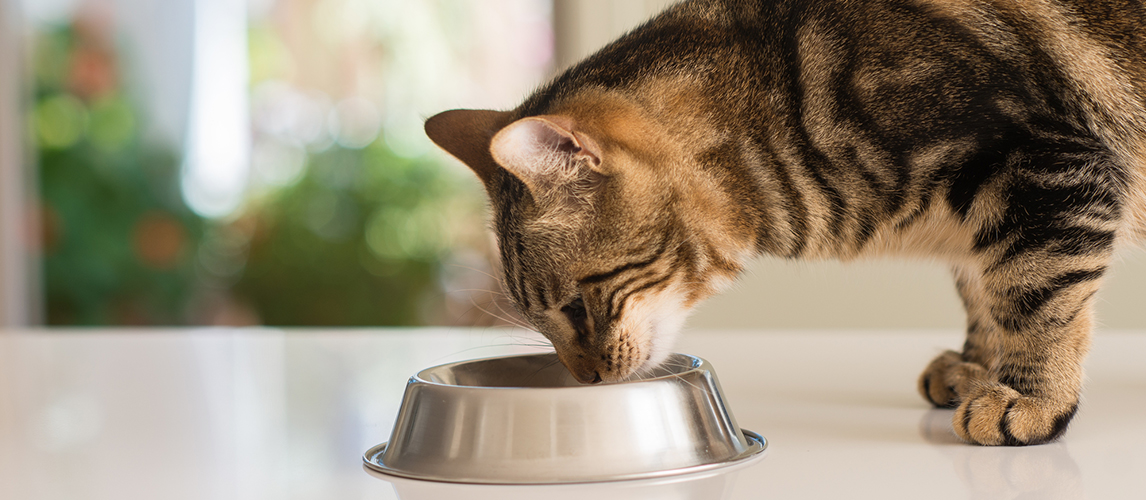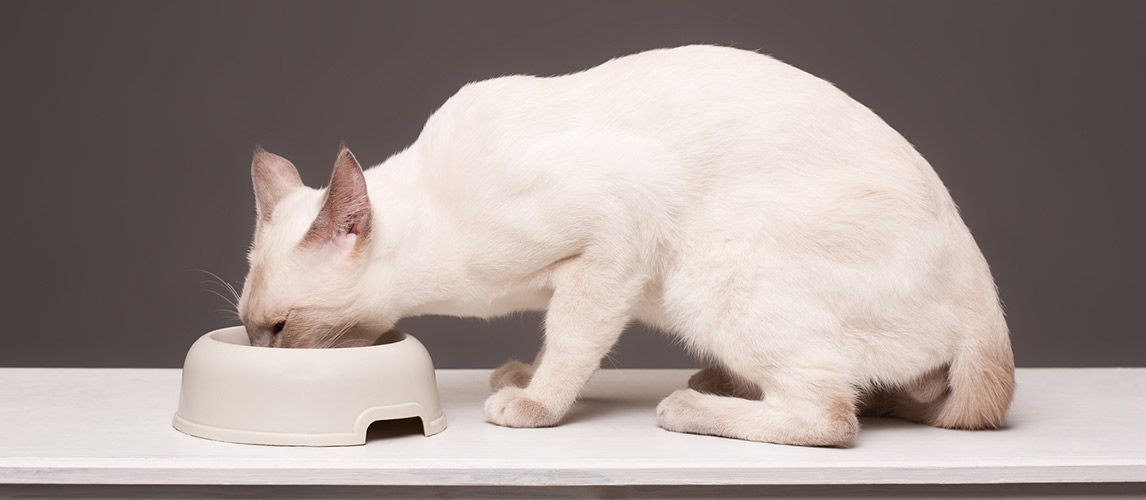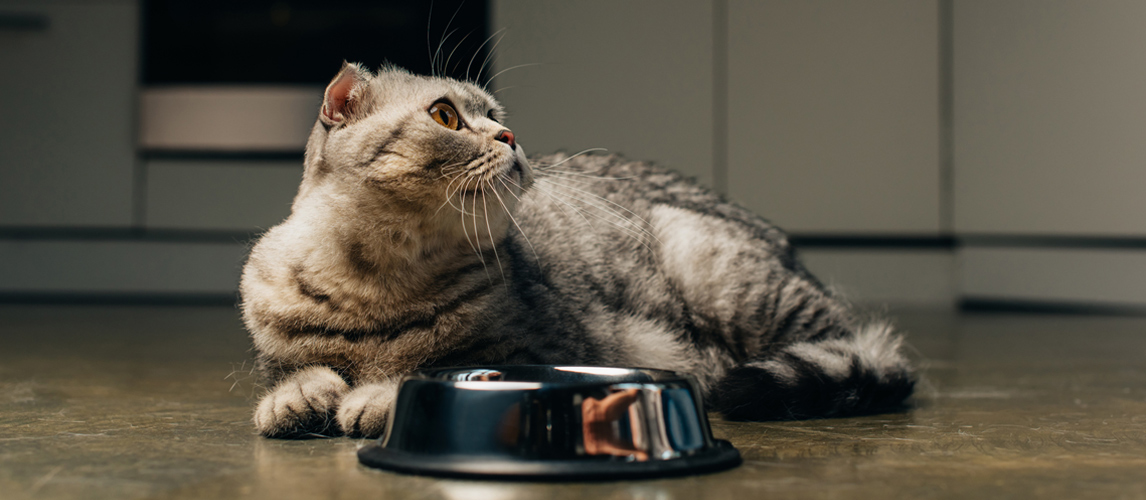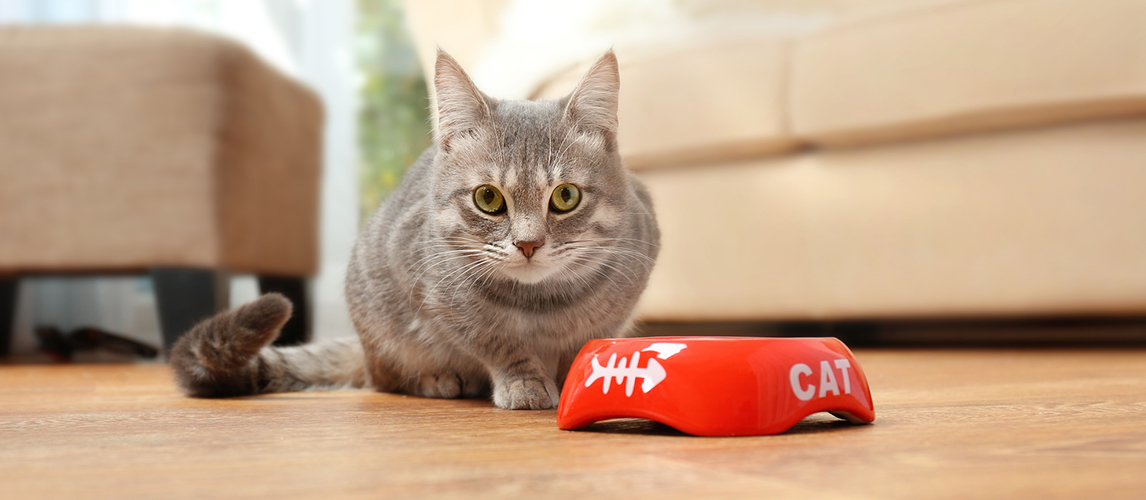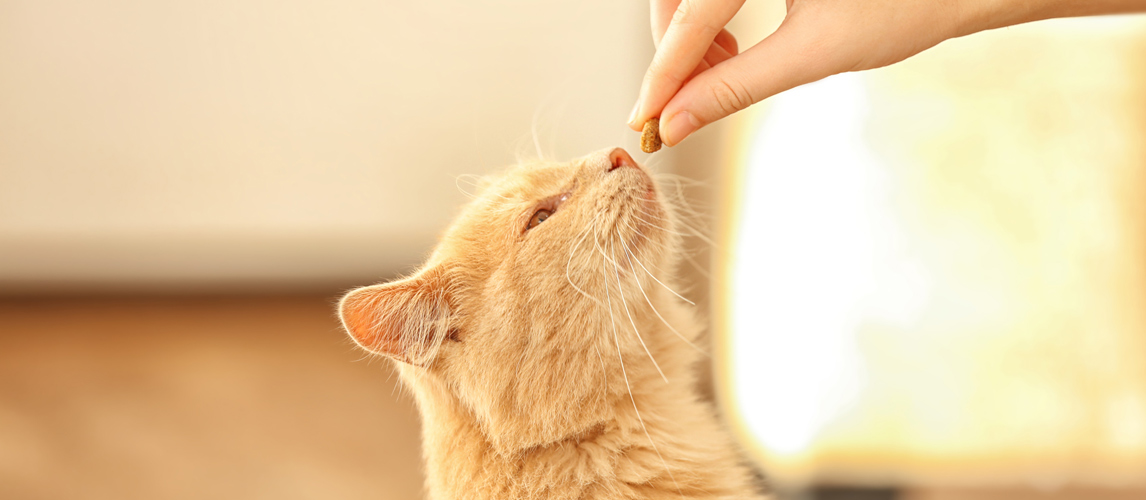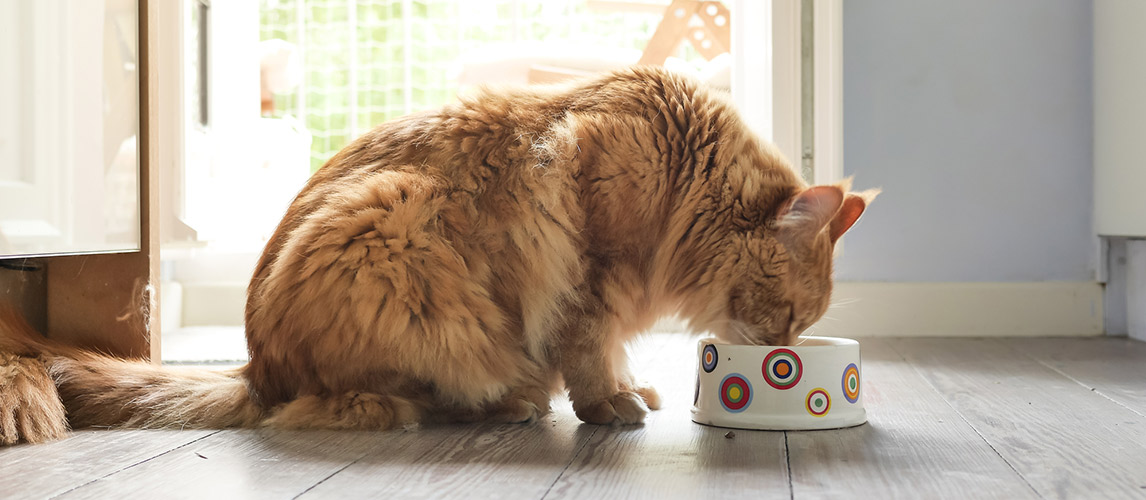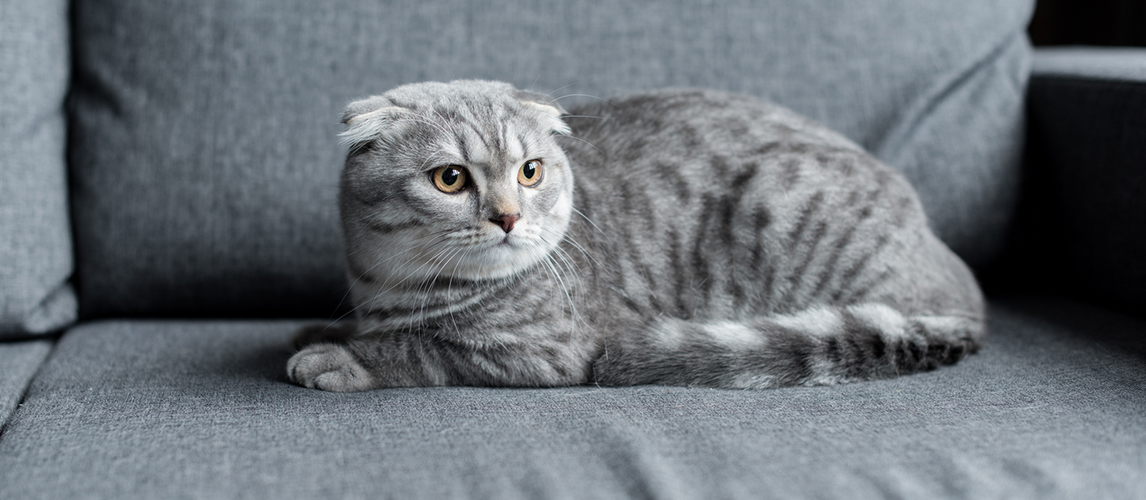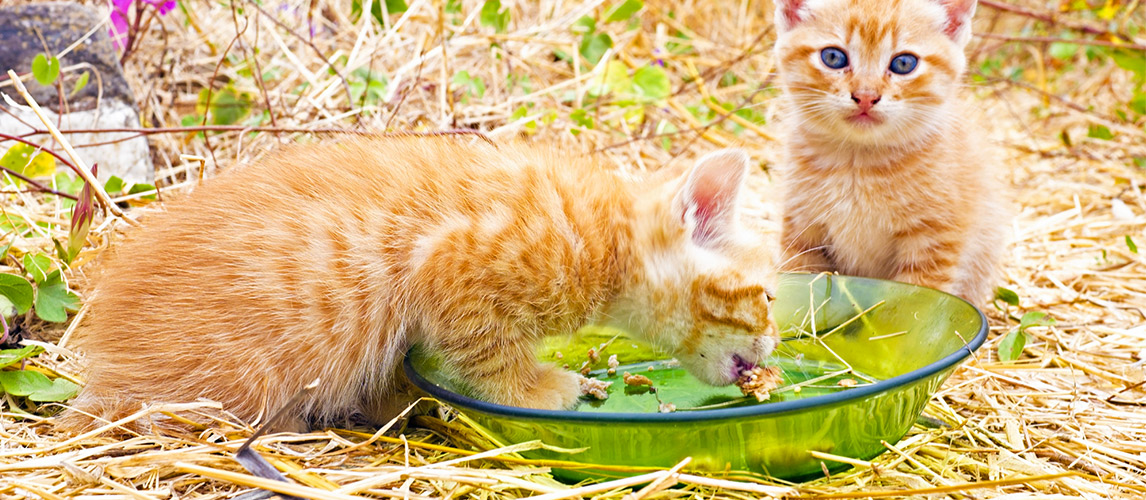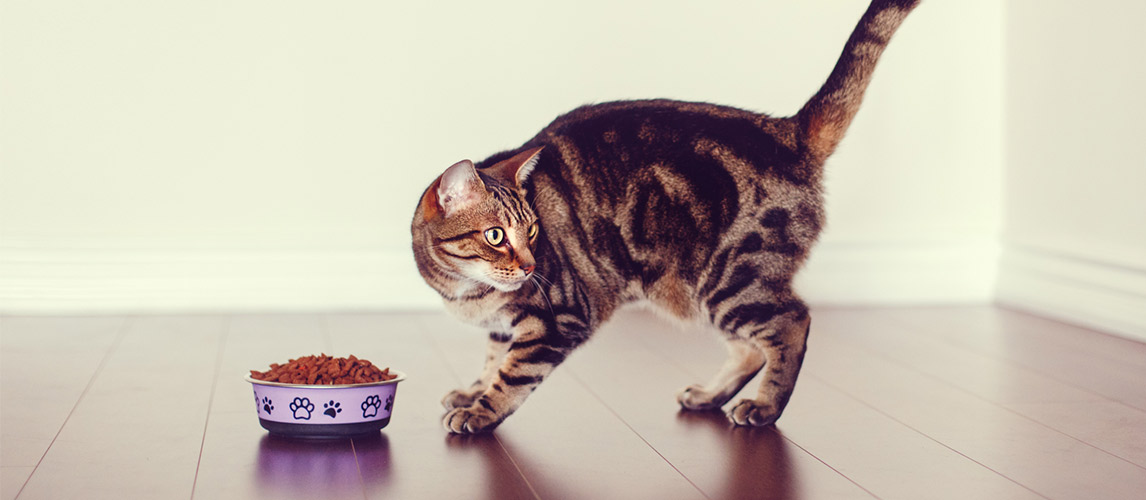High fiber cat foods are not considered necessary for every cat. Some researchers argue that, in nature, wild cats did not eat any plant fiber and, therefore, domestic cats do not need it either. The argument is that cats thrive on a high-protein diet that is packed with meat because they are true carnivores.
However, a domestic cat has a very different lifestyle to a wild cat. They are more sedentary and groom themselves more. Also, commercial cat food is very different from eating a whole mouse! When a cat eats a mouse, the bones and fur act as fiber as they pass through the intestines. Commercial cat food is smooth and does not have this type of ‘animal fiber’ so there is an argument that it needs plant fiber instead.
To help you understand the advantages and disadvantages of a high fiber cat food and to choose the best high fiber cat food for your kitty, here is our guide.
A Quick Overview of 10 Best High Fiber Cat Foods
| Editor's Picks | Product Name | Price | Rating |
|---|---|---|---|
| Best Overall | Blue Buffalo Wilderness Indoor Hairball & Weight Control Chicken Recipe | Buy on Amazon | 4.6 |
| Best Grain-Free | Wellness CORE Grain-Free Indoor Formula Dry Cat Food | Buy on Amazon | 4.0 |
| Best All Life Stages Food | Natural Balance Original Ultra Chicken Meal & Salmon Meal Formula | Buy on Amazon | 4.7 |
| Best for Senior Cats | Hill's Science Diet Adult 7+ Hairball Control Chicken Recipe | Buy on Amazon | 4.8 |
| Best for Healthy Skin | Merrick Limited Ingredient Diet Grain-Free Real Duck Pate Recipe | Buy on Amazon | 4.3 |
| Best for Indoor Cats | Halo Holistic Chicken & Chicken Liver Recipe Healthy Weight Indoor Cat | Buy on Amazon | 4.4 |
| Best for Overweight Cats | Purina ONE Indoor Advantage Adult Dry Cat Food | Buy on Amazon | 4.8 |
| Best Wet Food | Instinct Limited Ingredient Diet Grain-Free Pate Real Turkey Recipe | Buy on Amazon | 3.9 |
| Best for Sensitive Stomachs | Iams Proactive Health Sensitive Digestion & Skin Turkey Recipe | Buy on Amazon | 4.8 |
| Best Organic | Raw Paws Pet Organic Pure Pumpkin Powder for Cats | Buy on Amazon | 4.2 |
1 Best Overall: Blue Buffalo Wilderness Indoor Hairball & Weight Control Chicken Recipe
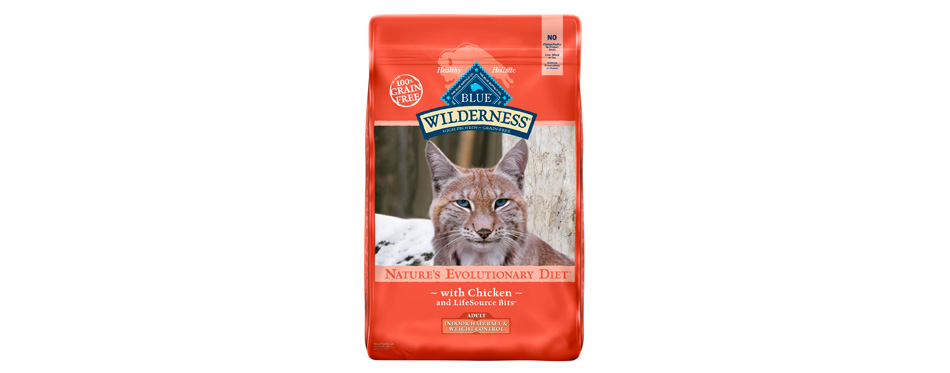
- Brand: Blue Buffalo
- First 5 ingredients: Deboned Chicken, Chicken Meal, Tapioca Starch, Pea Protein, Peas
- Primary Proteins: Chicken, Peas
- Calories: 410 kcal/cup
- Flavor: Chicken
- Life Stage: Adult
A protein-rich high fiber dry cat food based on the diet of the wild Lynx. It has a fiber content of 7.4% (max) and is completely grain-free. The protein content is provided by deboned chicken, chicken meal and fish meal. The carbohydrate content is provided by peas, potatoes, and sweet potatoes.
The recipe has been put together by animal nutritionists to control your cat’s weight and to combat furballs. This is achieved through a blend of naturally occurring sources of fiber including cellulose and psyllium seeds. There are plenty of vitamins and minerals to support a healthy immune system and promote a shiny coat.
You may also like our detailed review of Blue Buffalo Cat Food.
Deboned Chicken, Chicken Meal, Tapioca Starch, Pea Protein, Peas, Menhaden Fish Meal (source of Omega 3 Fatty Acids), Powdered Cellulose, Pea Fiber, Chicken Fat (preserved with Mixed Tocopherols), Flaxseed (source of Omega 6 Fatty Acids), Natural Flavor, Potato Starch, Choline Chloride, DL-Methionine, Psyllium Seed Husks, Potassium Chloride, Calcium Sulfate, Dehydrated Alfalfa Meal, Potatoes, Dried Chicory Root, Taurine, Calcium Carbonate, Caramel Color, Potassium Sulfate, Salt, preserved with Mixed Tocopherols, Sweet Potatoes, Carrots, L-Carnitine, Ferrous Sulfate, Niacin, Iron Amino Acid Chelate, Zinc Amino Acid Chelate, Zinc Sulfate, Vitamin E Supplement, Cranberries, Blueberries, Barley Grass, Parsley, Yucca Schidigera Extract, Dried Kelp, Turmeric, Copper Sulfate, Thiamine Mononitrate (Vitamin B1), Copper Amino Acid Chelate, Oil of Rosemary, L-Ascorbyl-2-Polyphosphate (source of Vitamin C), L-Lysine, Biotin (Vitamin B7), Vitamin A Supplement, Manganese Sulfate, Manganese Amino Acid Chelate, Pyridoxine Hydrochloride (Vitamin B6), Calcium Pantothenate (Vitamin B5), Riboflavin (Vitamin B2), Vitamin D3 Supplement, Vitamin B12 Supplement, Folic Acid (Vitamin B9), Dried Yeast, Dried Enterococcus faecium fermentation product, Dried Lactobacillus acidophilus fermentation product, Dried Aspergillus niger fermentation extract, Dried Trichoderma longibrachiatum fermentation extract, Dried Bacillus subtilis fermentation extract, Calcium Iodate, Sodium Selenite.

2 Best Grain-Free: Wellness CORE Grain-Free Indoor Formula Dry Cat Food

- Brand: Wellness
- First 5 ingredients: Deboned Chicken, Turkey Meal, Chicken Meal, Peas, Potatoes
- Primary Proteins: Chicken, Turkey & Peas
- Calories: 445 kcal/cup
- Flavor: Chicken, Turkey & Chicken Meal
- Life Stage: Adult
A carefully balanced kibble for cats that contains a high proportion of protein (38%) and a maximum of 5% fiber. The fiber is derived from natural sources and is designed to help with weight management for cats that have a less active, indoor lifestyle. The high-quality protein content is provided by deboned chicken, chicken meal and turkey meal.
There are no fillers or grains in the cat food and no soy, no meat by-products and no artificial additives. It contains 20% less fat than most standard commercial cat foods. Wellness CORE Grain-Free Indoor Formula is one of 5 cat food recipes mentioned in our Wellness Cat Food Review.
Deboned Chicken, Turkey Meal, Chicken Meal, Peas, Potatoes, Tomato Pomace, Ground Flaxseed, Chicken Fat (preserved with Mixed Tocopherols), Natural Chicken Flavor, Chicory Root Extract, Choline Chloride, Cranberries, Taurine, Vitamin E Supplement, Glucosamine Hydrochloride, Chondroitin Sulfate, Dried Kelp, L-Carnitine, Zinc Proteinate, Mixed Tocopherols added to preserve freshness, Zinc Sulfate, Calcium Carbonate, Niacin, Iron Proteinate, Ferrous Sulfate, Yucca Schidigera Extract, Vitamin A Supplement, Copper Sulfate, Thiamine Mononitrate, Copper Proteinate, Manganese Proteinate, Manganese Sulfate, d-Calcium Pantothenate, Sodium Selenite, Pyridoxine Hydrochloride, Riboflavin, Vitamin D3 Supplement, Biotin, Calcium Iodate, Vitamin B12 Supplement, Folic Acid, Ascorbic Acid (Vitamin C), Dried Lactobacillus plantarum Fermentation Product, Dried Enterococcus faecium Fermentation Product, Dried Lactobacillus casei Fermentation Product, Dried Lactobacillus acidophilus Fermentation Product, Rosemary Extract, Green Tea Extract, Spearmint Extract.

3 Best All Life Stages Food: Natural Balance Original Ultra Chicken Meal & Salmon Meal Formula
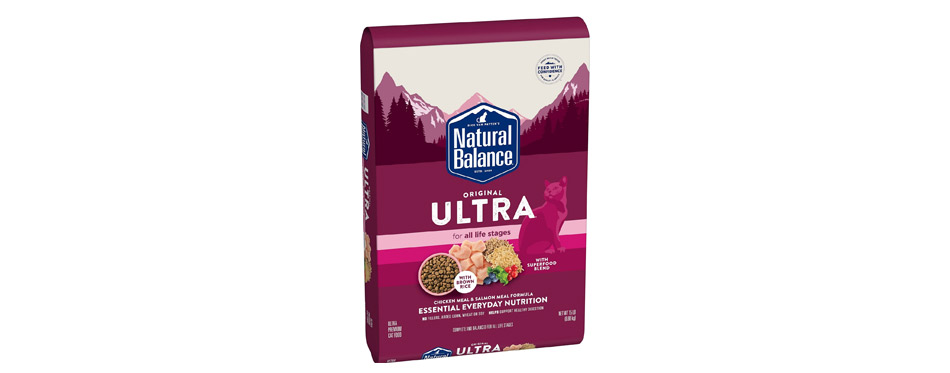
- Brand: Natural Balance
- First 5 ingredients: Chicken Meal, Brown Rice, Chicken, Chicken Fat, Brewers Dried Yeast
- Primary Proteins: Chicken, Salmon
- Calories: 425 kcal/cup
- Flavor: Chicken & Salmon
- Life Stage: All
The kibble carefully balances the protein content (provided by chicken meal and chicken) with carbohydrates, fats, fiber and vitamins and minerals. The fiber content is a maximum of 3% but is provided by layering multiple fiber sources to help your cat’s digestion.
It is suitable for cats of all ages and lifestyles and contains no artificial colors or flavors. There are carefully balanced levels of calcium and phosphorous to maintain strong bones.
Chicken Meal, Brown Rice, Chicken, Chicken Fat (Preserved With Mixed Tocopherols), Brewers Dried Yeast, Oat Groats, Chicken Liver, Salmon Meal, Natural Flavor, Menhaden Fish Oil (Preserved With Mixed Tocopherols), Pea Fiber, Oat Fiber, Salt, DL-Methionine, Potassium Chloride, Cranberries, Vitamins (Vitamin E Supplement, Ascorbic Acid (Source of Vitamin C), Niacin, Vitamin A Supplement, Thiamine Mononitrate , d-Calcium Pantothenate, Riboflavin Supplement, Pyridoxine Hydrochloride, Vitamin B12 Supplement, Folic Acid, Biotin, Vitamin D3 Supplement), Choline Chloride, Taurine, Minerals (Zinc Proteinate, Zinc Sulfate, Ferrous Sulfate, Iron Proteinate, Copper Sulfate, Copper Proteinate, Manganese Sulfate, Manganese Proteinate, Sodium Selenite, Calcium Iodate), Blueberries, L-Ascorbyl-2-Polyphosphate (Source Of Vitamin C), L-Tryptophan, Kelp, L-Lysine Monohydrochloride, Yucca Schidigera Extract, Citric Acid (Preservative), Lactic Acid, Mixed Tocopherols (Preservative), Rosemary Extract, Green Tea Extract, Spearmint Extract.

4 Best for Senior Cats: Hill’s Science Diet Adult 7+ Hairball Control Chicken Recipe

- Brand: Hill’s Science Diet
- First 5 ingredients: Chicken, Whole Grain Wheat, Corn Gluten Meal, Chicken Fat, Powdered Cellulose
- Primary Proteins: Chicken
- Calories: 333 kcal/cup
- Flavor: Chicken
- Life Stage: Adult 7+
A scientifically blended cat food that is formulated to control hairballs. The protein content is provided by the real chicken which is the primary ingredient. There are omega 6 fatty acids and vitamin E to help the skin and coat to stay healthy.
The added antioxidants (vitamins C and E) support a healthy immune system. The natural fiber blend helps your cat’s digestive system to remove hairballs comfortably. The whole formula is easy to digest and contains no artificial colors, flavors or preservatives.
Check out our detailed guide on Hill’s Cat Food.
Chicken, Whole Grain Wheat, Corn Gluten Meal, Chicken Fat, Powdered Cellulose, Wheat Gluten, Brewers Rice, Dried Beet Pulp, Chicken Liver Flavor, Lactic Acid, Potassium Chloride, Calcium Sulfate, Fish Oil, Dicalcium Phosphate, Choline Chloride, Calcium Carbonate, Taurine, vitamins (Vitamin E Supplement, L-Ascorbyl-2-Polyphosphate (source of Vitamin C), Niacin Supplement, Thiamine Mononitrate, Vitamin A Supplement, Calcium Pantothenate, Riboflavin Supplement, Biotin, Vitamin B12 Supplement, Pyridoxine Hydrochloride, Folic Acid, Vitamin D3 Supplement), Iodized Salt, minerals (Ferrous Sulfate, Zinc Oxide, Copper Sulfate, Manganous Oxide, Calcium Iodate, Sodium Selenite), L-Carnitine, Oat Fiber, Mixed Tocopherols for freshness, Natural Flavors, Beta-Carotene, Apples, Broccoli, Carrots, Cranberries, Green Peas.

5 Best for Healthy Skin: Merrick Limited Ingredient Diet Grain-Free Real Duck Pate Recipe
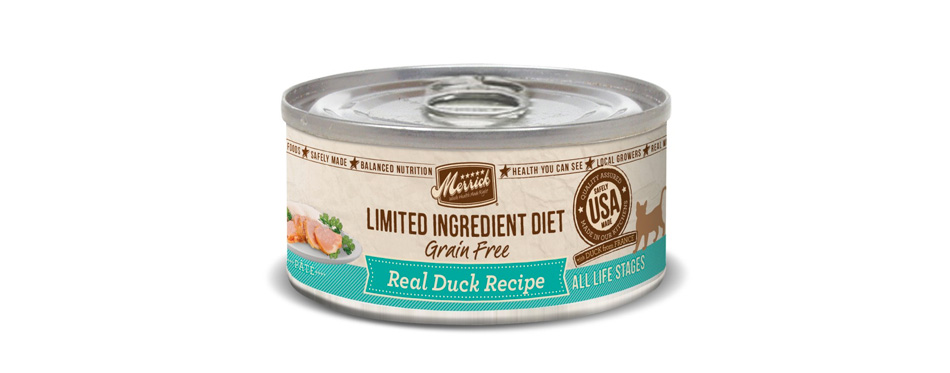
- Brand: Merrick
- First 5 ingredients: Deboned Duck, Water for Processing, Natural Flavor, Pea Protein, Calcium Carbonate
- Primary Proteins: Duck
- Calories: 175 kcal/5 oz can
- Flavor: Duck
- Life Stage: Adult
A premium high fiber wet cat food available in small (5oz) cans of wet food. Several flavors are available including duck, chicken, and salmon. In the duck recipe, the protein is provided by deboned duck and there are limited ingredients to make it easier to control what your cat is eating. This makes it ideal for cats with food sensitivities.
The recipe contains no fish, gluten or grain to make it easier to digest. It has plenty of Omega 3 and Omega 6 fatty acids to promote a healthy coat.
Take a look at our review of Merrick Cat Food.
Deboned Duck, Water for Processing, Natural Flavor, Pea Protein, Calcium Carbonate, Organic Alfalfa Meal, Sodium Phosphate, Guar Gum, Potassium Chloride, Salt, Flaxseed Oil, Vitamins (Vitamin E Supplement, Vitamin B12 Supplement, d-Calcium Pantothenate, Vitamin A Supplement, Niacin, Vitamin D3 Supplement, Riboflavin Supplement, Pyridoxine Hydrochloride, Folic Acid, Biotin, Thiamine Mononitrate), Choline Chloride, Minerals (Zinc Amino Acid Complex, Iron Amino Acid Complex, Manganese Amino Acid Complex, Copper Amino Acid Complex, Potassium Iodide, Cobalt Glucoheptonate, Sodium Selenite), Taurine, Yucca Schidigera Extract.

6 Best for Indoor Cats: Halo Holistic Chicken & Chicken Liver Recipe Healthy Weight Indoor Cat
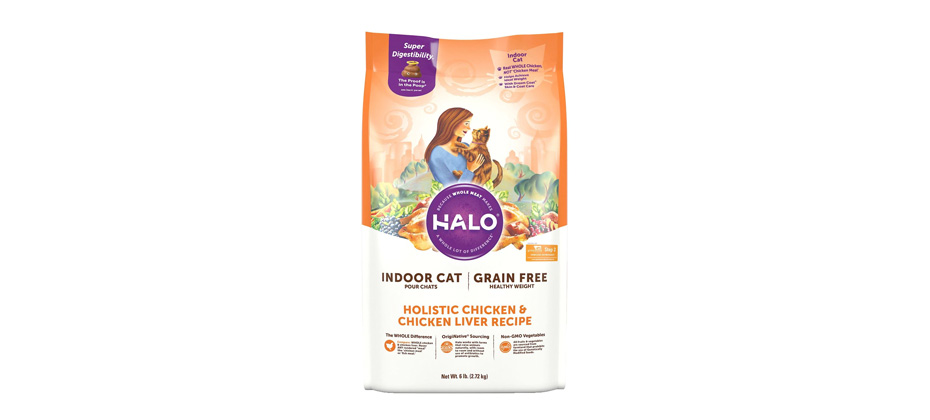
- Brand: Halo
- First 5 ingredients: Chicken, Chicken Liver, Dried Egg Product, Dried Peas, Dried Chickpeas
- Primary Proteins: Chicken, Egg & Peas
- Calories: 397 kcal/cup
- Flavor: Chicken & Chicken Liver
- Life Stage: Adult
A grain-free recipe formulated especially for cats that live indoors and need a high protein, high fiber diet. It is made with whole chicken as the protein source with no rendered meat meals. This makes it easier to digest as more of the nutrients are available to your cat’s intestines.
The recipe is grain-free and contains chickpeas and vegetables to provide fiber. It helps your indoor cat to maintain a healthy weight by reducing the calories and the fat content. There is added L-Carnitine to boost their metabolism. The focus is on natural ingredients and there is no meat derived from factory-farmed animals or animals raised with the use of antibiotics or growth hormones. Halo Holistic Chicken & Chicken Liver is one of 5 cat food recipes mentioned in our Halo Cat Food Review.
Chicken, Chicken Liver, Dried Egg Product, Dried Peas, Dried Chickpeas, Soy Protein Concentrate, Dried Potatoes, Natural flavor, flaxseed, Pea fiber, Potato Protein, Chicken Fat (Preserved With Mixed Tocopherols), Salmon Oil, Calcium Sulfate, Dicalcium Phosphate, Dried Bacillus Coagulans Fermentation Product, Dried Blueberries, Dried Cranberries, Dried Carrots, Dried Sweet Potatoes, Salt, Inulin, Vitamins (Vitamin E Supplement, Niacin Supplement, Thiamine Mononitrate, D-Calcium Pantothenate, Vitamin A Supplement, Pyridoxine Hydrochloride, Riboflavin Supplement, Vitamin D3 Supplement, Vitamin B12 Supplement, Folic Acid, Biotin), Potassium Chloride, Minerals (Zinc Proteinate, Iron Proteinate, Copper Proteinate, Manganese Proteinate, Sodium Selenite, Calcium Iodate), Taurine, Mixed Tocopherols (Preservative), L-Ascorbyl-2-Polyphosphate, L-Carnitine.

7 Best for Overweight Cats: Purina ONE Indoor Advantage Adult Dry Cat Food

- Brand: Purina ONE
- First 5 ingredients: Turkey, Chicken By-Product Meal, Rice, Corn Gluten Meal, Soybean Meal
- Primary Proteins: Turkey, Chicken & Beef
- Calories: 372 kcal/cup
- Flavor: Turkey
- Life Stage: Adult
For adult indoor cats that may have issues with weight management and fur balls, this dried cat food helps your kitty to maintain optimum health. It’s packed with protein and has turkey as the primary ingredient. Then there are added vitamins and minerals to maintain a healthy digestion and coat.
There are no fillers and a natural blend of fiber which helps to control weight in cats that are not very active and helps to naturally get rid of fur balls. The crunchy kibble also helps with plaque build-up. The Omega 6 fatty acids are there to support your cat’s healthy coat which also helps with hairballs. Purina ONE Indoor Advantage Adult Dry Cat Food is one of 5 recipes included in our review of the Purina One product line.
Turkey, Chicken By-Product Meal, Rice, Corn Gluten Meal, Soybean Meal, Whole Grain Corn, Soy Protein Isolate, Powdered Cellulose, Dried Yeast, Soybean Hulls, Beef Fat Preserved With Mixed-Tocopherols, Canola Meal, Natural Flavor, Phosphoric Acid, Calcium Carbonate, Caramel Color, Salt, Dried Carrots, Dried Spinach, Choline Chloride, L-Lysine Monohydrochloride, MINERALS [Zinc Sulfate, Ferrous Sulfate, Manganese Sulfate, Copper Sulfate, Calcium Iodate, Sodium Selenite], Taurine, Potassium Chloride, VITAMINS [Vitamin E Supplement, Niacin (Vitamin B-3), Vitamin A Supplement, Calcium Pantothenate (Vitamin B-5), Thiamine Mononitrate (Vitamin B-1), Riboflavin Supplement (Vitamin B-2), Vitamin B-12 Supplement, Pyridoxine Hydrochloride (Vitamin B-6), Folic Acid (Vitamin B-9), Vitamin D-3 Supplement, Biotin (Vitamin B-7), Menadione Sodium Bisulfite Complex (Vitamin K)]. P418820.

8 Best Wet Food: Instinct Limited Ingredient Diet Grain-Free Pate Real Turkey Recipe
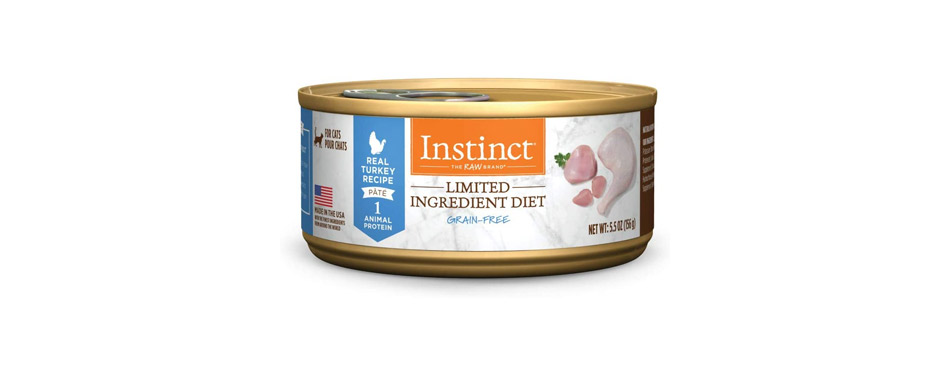
This is a wet cat food with limited ingredients so it is suitable for cats that have food sensitivities. It has only one source of protein which is a farm-raised duck but rabbit and turkey flavors are also available. This is an easily digestible protein source. There is one vegetable (peas) and no grain, dairy products or eggs.
Cats with sensitivities to grain, dairy products, and eggs will have no problems with this formula and it also has no chicken, beef, fish, corn, wheat or soy. It provides a complete and balanced meal for cats of all ages. If you want to find out more about their company, product lines, and recall history, read our overview of Nature’s Variety Instinct Cat Food.
Turkey, Turkey Broth, Turkey Liver, Peas, Pea Protein, Montmorillonite Clay, Potassium Chloride, Minerals (Iron Proteinate, Zinc Proteinate, Copper Proteinate, Manganese Proteinate, Sodium Selenite, Potassium Iodide), Salt, Choline Chloride, Vitamins (Vitamin E Supplement, Thiamine Mononitrate, Niacin Supplement, d-Calcium Pantothenate, Pyridoxine Hydrochloride, Riboflavin Supplement, Vitamin A Supplement, Biotin, Vitamin D3 Supplement, Vitamin B12 Supplement, Folic Acid), Taurine, L-Ascorbyl-2-Polyphosphate

9 Best for Sensitive Stomachs: Iams Proactive Health Sensitive Digestion & Skin Turkey Recipe

- Brand: Iams
- First 5 ingredients: Turkey, Chicken By-Product Meal, Ground Whole Grain Corn, Brewers Rice, Chicken Meal
- Primary Proteins: Turkey, Chicken
- Calories: 352 kcal/cup
- Flavor: Turkey
- Life Stage: Adult
Designed specifically for cats with sensitive stomachs, this formulation has everything your cat needs to have a healthy digestive system. The fiber content is carefully blended and there are added prebiotics and beet pulp to aid digestion.
This sensitive stomach cat food is suitable for all adult cats and chicken is the primary ingredient, it provides most of the protein and is easy for cats to digest. It is enriched with antioxidants to support the immune system and omega oils to keep the coat healthy. Iams Proactive Health Sensitive Digestion & Skin Turkey is one of 5 recipes included in our review of the Iams Cat Food.
Turkey, Chicken By-Product Meal, Ground Whole Grain Corn, Brewers Rice, Chicken Meal, Corn Gluten Meal, Chicken Fat (Preserved with Mixed Tocopherols), Ground Sorghum, Dried Plain Beet Pulp, Fish Oil (Preserved with Mixed Tocopherols), Natural Flavor, Sodium Bisulfate, Caramel Color, Fructooligosaccharides, Dried Egg Product, Potassium Chloride, Brewers Dried Yeast, Choline Chloride, Vitamins [Vitamin E Supplement, Niacin, Ascorbic Acid, Vitamin A Acetate, Calcium Pantothenate, Biotin, Thiamine Mononitrate (Source of Vitamin B1), Pyridoxine Hydrochloride (Source of Vitamin B6), Vitamin B12 Supplement, Riboflavin Supplement (Source of Vitamin B2), Inositol, Vitamin D3 Supplement, Folic Acid], Taurine, Calcium Carbonate, Minerals [Zinc Oxide, Manganese Sulfate, Copper Sulfate, Potassium Iodide], L-Carnitine, Rosemary Extract.

10 Best Organic: Raw Paws Pet Organic Pure Pumpkin Powder for Cats
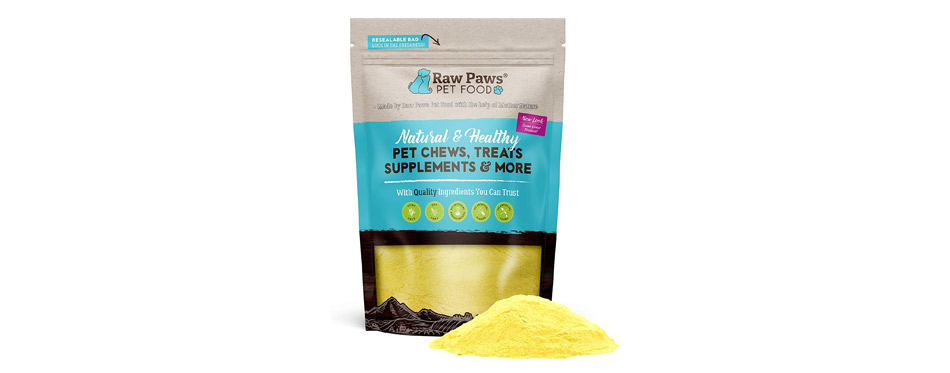
- Brand: Raw Paws
- First 5 ingredients: 100% Pure Pumpkin Powder
- Primary Proteins: Pumpkin
- Calories: 108 kcal/oz
- Flavor: Pumpkin
- Life Stage: All
This is not a complete cat food, it is a therapeutic cat fiber supplement that is used to help cats that have diarrhea or constipation. It provides both soluble fiber and antioxidants to boost the immune system. Together they promote the healthy formation of the stool (poop) and regular bowel movements.
It consists of nothing but powdered pumpkin and is 100 % organic. All you have to do is sprinkle it over your cat’s usual food.
100% Pure Pumpkin Powder

Best High Fiber Cat Food Buying Guide & FAQ
How Does Fiber Help Your Cat?
Fiber is a type of carbohydrate and is an important part of your cat’s diet. In nature, they would get fiber from the prey that they eat but your domestic kitty needs to get it from cat food. Fiber does not get broken down by the body in the way that protein and fats do. They pass through the body and come out as poop.
For a cat, fiber is essential to keep food moving through the intestines at the right rate. It helps your cat’s intestine to form a poop that is not too hard and not too soft. In this way, it helps to prevent both constipation and diarrhea. You can use a high fiber cat food for constipation and for diarrhea.
Intestinal and weight management issues can arise in domestic cats because they have a very different lifestyle to wild cats. They are not so active, they sleep for longer periods and they groom themselves more. So, whilst your kitty’s wild cousins may not need plant fiber in their diet, your domestic kitty will.

Why You Should Feed Your Cat a High Fiber Food
Domestic cats could benefit from a high fiber diet and from foods with fiber in them. You may read that some commercial cat food is formulated just for indoor cats. It is designed to tackle some of the health problems that they face. Here are some of the specific conditions that it can help with:
- Hairballs
Domestic cats groom themselves more than wild cats, perhaps because they have more time on their hands! As they lick their fur, the tiny hooks on their tongue get caught in loose hairs and pull them off. They end up in your cat’s mouth and they swallow them. Most of the hair will pass through the intestines just like food does. However, some of it will stay in the stomach and eventually it clump together to form a hairball.
Getting rid of a hairball is a pretty unpleasant business. Your cat will heave and eventually vomit the hairball up. They land on the floor looking quite long and tubular because they have been forced up the narrow tube connecting the stomach and the mouth. Hairballs are more common in cat breeds with long hair and in adult cats compared to kittens.
If your cat successfully vomits up the hairball, all is well. However, problems can arise if they don’t manage to do this. The following symptoms could mean that your cat has a hairball lodged in their intestines:
- Continual or repeated vomiting and gagging without producing a hairball
- Loss of interest in food
- Lethargy and lack of energy
- Constipation or diarrhea
If this happens, you need to get your kitty to a vet quickly.
Hairballs can be prevented by high fiber diets. Some commercial cat food is actually advertised as ‘hairball formula’ or as ‘hairball reduction’. The diets work in two ways. Firstly, they contain vitamins, minerals and fatty acids that promote a very healthy coat. This should cut down on shedding and reduces the number of hairs that enter the intestine. Secondly, they help food to move efficiently through the intestine and to take the hairball with it so that it passes out with the poop. The different types of fiber in the food are carefully blended to achieve this.
You may also like our review of Cat Food for Hairballs.
- Obesity
Unfortunately, humans are not the only ones to be in the midst of an obesity epidemic. A study by APOP (Association for Pet Obesity Prevention) conducted in 2011 found that over half of domestic cats were either obese or overweight. There is no such thing as an obese wildcat so clearly, something is going wrong.
The simple explanation is that domestic cats are taking in more calories than they are burning off. In the wild, a cat could go for days without finding any prey. They get a lot of exercise walking around looking for their next meal and chasing it when they find it. Now compare that to a domestic cat. They spend a lot of time sleeping and lounging around. When they are hungry, all they have to do is wander over to the food bowl and perhaps meow at you to produce some food. Commercially produced cat food is convenient but will have more sugars and other fattening ingredients in it than a cat’s natural diet of raw prey. All of these factors put together has resulted in an obesity problem in the US domestic cat population.
A high fiber diet can help and many foods containing carefully blended fiber are advertised as suitable for weight management. The fiber content helps your cat to feel satisfied after a meal but does not contribute to their calorie intake because it passes through the gut without being absorbed.
- Constipation and diarrhea
Cats can suffer from either constipation or diarrhea. When a cat is constipated, it can be because the food is passing too slowly through the intestines and it is too dry. This makes the poop hard and difficult to pass. In diarrhea, the opposite happens. The food passes too quickly through the intestines, has too much water in it and comes out too runny. Neither are desirable. When a cat’s gut is working well, they will pass regular, well-formed poops.
Fiber has an important role to play in controlling both conditions. For a cat that is constipated, it can help to draw water into the large intestine and make the poop softer and easier to pass. Where diarrhea is the problem, the correct fiber will help to slow down the passage of the stool so that more water can be absorbed out of it and the poop is firmer. Ingredients such as beet pulp contain both types of fiber as does pumpkin.

The Different Types Of Fiber In Cat Food
All mammals need some sort of fiber in their diet. Fiber is the part of food that is impossible to digest. It travels through the intestine and comes out the other end as poop.
Fiber can be plant-based or animal-based. The natural diet of your kitty is small rodents (rats and mice) and cats eat the entire thing. This means that they would eat the fur, bone, and cartilage as well which are pretty tough. The cat’s digestive system cannot break these down and so they pass through and function like an animal-based fiber.
Wildcats consume very little plant-based fiber. When they eat their prey, the last thing they eat from the carcass is the intestines which would contain some partially digested plant material. Their prey’s last meal!
Plant-based fiber can be categorized as soluble fiber which is rapidly fermentable and insoluble fiber which is slowly fermentable. Here’s how they work.
- Soluble fiber: You will see these written on ingredients lists as things like pectin and gum. When they reach the large intestine (colon) they draw water out of the bloodstream and into the food that is passing through. The bacteria that are found in the colon are able to ferment them and when they do this, they produce short-chain fatty acids. These are very useful for the cells of the colon. The overall effect is that they can relieve constipation by drawing water into the poop and making it softer. This also has the effect of making it travel through the gut faster.
- Insoluble fiber: This type of fiber is included in cat food formulations as cellulose or peanut hulls. They have the effect of making the food more bulky as it travels through the intestine and it travels more slowly. This type of fiber can help with diarrhea.
- Moderately fermentable fiber: Often the fiber sources in cat foods have some soluble and some insoluble properties. Typical examples are bran and beet pulp.
What to Look for in a Good High-Fiber Food for Cats
The good high fiber cat foods have ingredients that promote general digestive health and have all the nutrients that your cat needs. In particular, look out for:
- High protein content. Cats are true carnivores and need all of their protein from high quality meat sources. Meat or fish should be the first ingredient on the ingredients list.
- Mix of soluble and insoluble fiber. A cat needs both types of fiber to keep their digestion healthy and working efficiently. For example, a combination of cellulose and psyllium seeds may be used.
- Ingredients to help with specific issues if needed. If your cat has a specific health issue such as obesity or fur balls, you may need ingredients to help with this. Omega 6 fatty acids are often added to help with fur balls and the overall calorie content is important for weight management.
- No rendered meat meals or fillers. Rendered meat meals can cause allergies in some cats and are not the best source of protein. Also, fillers are cheap and bulk out the food but do not offer much in the way of nutrition.
Problems With High Fiber Cat Food
A high fiber diet for cats is not without its risks and drawbacks. For that reason, it is important that you always speak to your vet before switching your cat onto one. In some circumstances, the extra fiber will get stored as fat and that makes weight management more difficult. Also, the high proportion of carbohydrates can lead to less protein being absorbed. Cats need a lot of protein to make lean muscle mass which speeds up the metabolism. A slow metabolism equals weight gain and that is not good news. Some animal nutritionists argue that there is no need for carbohydrate fiber in a cat’s diet. Others maintain that they need a replacement for the animal ‘fiber’ that they would eat in the wild.
To avoid the potential problems with a high fiber diet for cats, here are a few of the things that you should look out for in commercial cat food.
- High protein: The fiber content should not be increased at the expense of protein so always look for a high protein cat food. Cats are natural carnivores and must have a lot of meat in their diet. Sources of fiber are cheaper and so it is tempting for cat food manufacturers to remove some of the meat and replace it with carbohydrates and that is not good for your cat.
- Allergens: Bear in mind that your cat’s intestinal problems could be caused by a food allergy or sensitivity. Speak to your vet about this before you just assume that your cat needs a high fiber diet. Many of the best commercial cat foods do not include common allergens such as grains and artificial additives.
- Type of fiber: Remember that you need soluble and non-soluble fiber. The higher quality insoluble sources of fiber include flax seeds and whole grain.
- Moderately fermentable fiber: This can be very beneficial because it does the job of both types of fiber. It is found in ingredients such as peas, oat bran, pumpkins and beet pulp.
- Protein to carbohydrate ratio: Ideally, you should be looking for a high protein and low carbohydrate diet for weight loss.
- Nutrients for a healthy coat: It is ideal if the food contains Omega 3 and Omega 6 fatty acids which will help to keep your cat’s coat in the best condition. This will reduce shedding and cut down on the number of hairballs that are produced.

Our Top Pick
Blue Buffalo Wilderness High Protein Grain Free
The ideal high fiber, high protein dry cat food based on the diet of the wild cats. The main ingredient is a protein which is provided by deboned chicken, chicken meal and fish meal. Then there are carbohydrates in the form of peas, potatoes, and sweet potatoes.
This is a food that has been carefully balanced to help hairballs pass through the intestines easily. It can also be a useful food for weight management. It contains a blend of different types of fiber including cellulose and psyllium seeds. To help to prevent hair loss there are plenty of vitamins and minerals to support a healthy coat.
Sources:
- Ken Tudor, DVM, Do Cats Need Fiber in Their Diet?, Pet MD
- Amy Flowers, DVM, What to Do About Hairballs in Cats, Pets Web MD
FAQs:
The optimal level of fiber for cats is thought to be around 1.5% to 3.5% but anything up to 10% is acceptable for some cats. Many commercial cat foods have far less than this. If your vet has advised that your cat should have a high fiber diet look for one that has at least 1.5% fiber but also look at the source of fiber in the ingredients list.
Cats need fiber sources that are fairly fermentable. Cellulose is not very fermentable and cannot be broken down very easily into short-chain fatty acids that can be used for energy. On the other hand, fiber from gums and pectin is so fermentable that it can cause excessive stools and gas. A good source is beet pulp which moderately fermentable and offers the benefits of fiber without the disadvantages.
There are many different types of fiber and it can be hard to predict the effect it will have on your cat’s digestion so always proceed with caution and seek your vet’s advice. They may suggest that you start with small quantities of a natural fiber such as pumpkin or that you try a fiber supplement designed for cats.
Unlike humans, cats do not need that much fiber. If cats have too much fiber in their diet they will find it harder to digest the rest of the nutrients in their diet and this reduces the nutrient quality of what they are eating. Also, if the fiber is highly fermentable, they can end up spending a lot of time in their litter tray and suffering from excessive gas.

